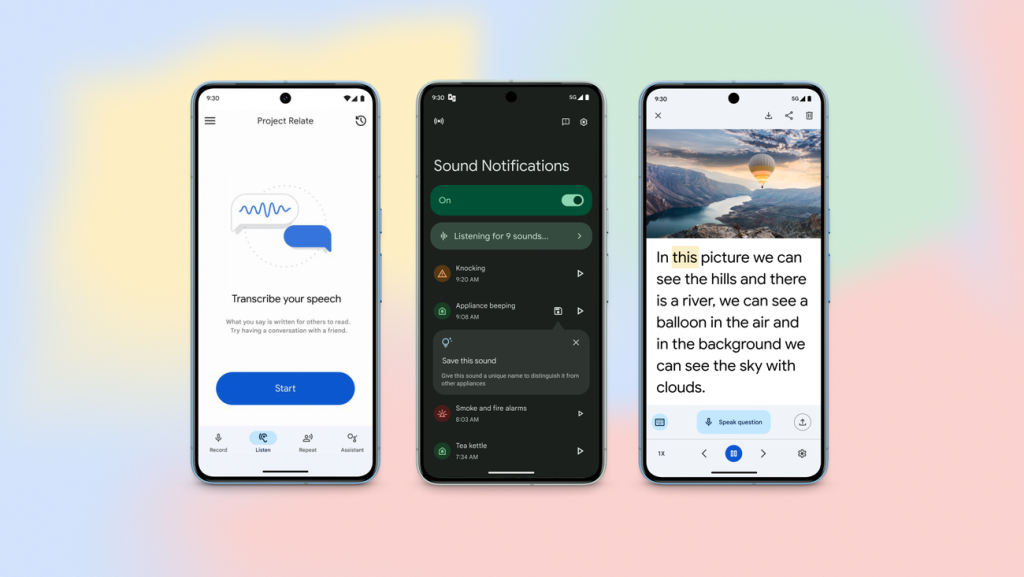Exciting AI Updates Boost Accessibility for All

On Global Accessibility Awareness Day, Google unveiled a series of groundbreaking updates aimed at improving technology access for people with disabilities. These updates span various Google products, offering innovative and user-friendly solutions. From navigating spaces easier to enhancing communication methods, Google’s new features show a commitment to making technology inclusive and accessible for everyone. Let’s dive into these updates and see how they are transforming lives.
AI-powered Accessibility Updates for Android
Google has introduced new tools to help people with disabilities use their mobile devices more effectively. The updated Lookout app now includes a beta feature called ‘Find mode.’ This allows users to locate specific objects in their environment by moving their camera around. The app will notify users of the direction and distance to items like seating, tables, or bathrooms.
Another important feature is AI-generated image captions in Lookout. This tool is especially useful for those with vision impairments. When users take a photo within the app, it provides a description of the image. This feature helps users understand more about their surroundings and the pictures they capture.
Text-Free Communication with Look to Speak
The Look to Speak app is getting a significant upgrade. Previously, it allowed users to select pre-written phrases with their eyes and have them spoken aloud. Now, a new text-free mode is rolling out. This mode enables users to select and personalize emojis, symbols, and photos to activate speech. It’s designed to assist those facing cognitive differences, literacy challenges, and language barriers.
The text-free mode is based on community feedback, highlighting the importance of real-world input in developing accessibility tools. It aims to make communication more inclusive and accessible for everyone.
Hands-Free Cursor for Android Developers
Project Gameface, a hands-free, open-source gaming mouse for PC, is now available for Android devices. This tool allows users to control a cursor using facial expressions. Developers can access Project Gameface via Github to build applications that support various user needs.
This initiative was developed in collaboration with Incluzza, a social enterprise in India. Through this partnership, Project Gameface has been expanded to educational and work settings, allowing people with disabilities to perform tasks like typing messages or searching for jobs.
The hands-free cursor can be customized in numerous ways. Users can adjust facial expressions, gesture sizes, and cursor speed to suit their individual needs. This flexibility makes it a versatile tool for people with various types of disabilities.
Expanded Accessibility Features in Maps
Google Maps is becoming even more user-friendly for people with disabilities. Detailed voice guidance and screen reader capabilities are now available globally for both Android and iOS. These features provide information about nearby places and offer audio prompts for navigation.
Maps now include accessibility information for over 50 million places. The ♿ icon indicates locations with wheelchair-accessible entrances. Detailed information about accessible restrooms, parking, and seating is also available.
Introducing Auracast for Hearing Assistance
Auracast is a new feature for those who need hearing assistance. Business owners can add the Auracast attribute to their profiles, enabling venues to broadcast enhanced audio to visitors with Auracast-enabled Bluetooth devices. This is especially useful in places like theaters and auditoriums.
This feature expands the accessibility options available to people with hearing impairments. It allows them to enjoy various activities in public spaces more fully.
New Designs for Project Relate and Sound Notifications
Project Relate has been updated to better serve people with non-standard speech. The app now allows users to create personalized speech recognition models. Custom Cards can be used to teach the model specific phrases that are important to the user.
Sound Notifications have also been redesigned based on user feedback. These notifications alert users to important household sounds like doorbells or smoke alarms. The updates make it easier to set up and customize the notifications according to individual needs.
Global Accessibility Awareness Day: A Commitment to Inclusion
These updates were announced on Global Accessibility Awareness Day. The day aims to raise awareness about digital access and inclusion for the 1.3 billion people with disabilities worldwide. Google’s new features show a commitment to making technology more accessible for everyone.
These accessibility updates from Google represent a major leap forward in making technology more inclusive. By harnessing the power of AI, they are enhancing the lives of people with disabilities. From helping users navigate their environment to improving communication methods, these tools are impactful. Google’s continued dedication to accessibility sets an inspiring example for tech innovation.




